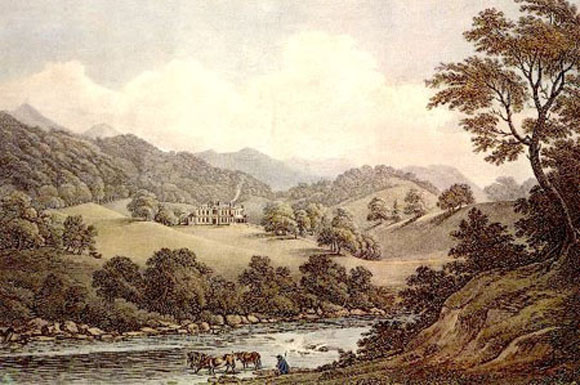|
Hafod Uchtryd
The estate of Hafod Uchtryd (English: summer mansion of Uchtryd) is located in Ceredigion, Wales the Ystwyth valley near Devil's Bridge, Cwmystwyth and Pont-rhyd-y-groes (English: the bridge of the cross). It is the ancient location of a dwelling on the side of the hill above the river Ystwyth, looking to the east. First used as a hunting lodge for Welsh Chieftans, it then became home to landed gentry and nobility.
History
The lands of the Hafod Uchtryd were within the boundaries of the Cistercian Abbey Strata Florida (Welsh: Caron-Uwch-Clawdd). After the dissolution of the monasteries by Henry VIII (1536-1540) during the English Reformation the abbey's holdings were divided and awarded to new tenants. Some of the Strata Florida lands were granted to the Herbert family, who came to Cardiganshire during the reign of Elizabeth I. Sir Richard Herbert of Pengelly and Cwmystwyth was High Sheriff of Cardigan from 22 November 1542.
A rent roll dated 1540 for the granges of Mevenith, Cwmystwyth and Hafodwen (‘newe leases’) reveals that W[illia]m Herbert and Morgan Herbert were tenants of several properties formerly belonging to the Abbey of Strata Florida, including significantly: Havodychdryd Doleygors Pantycrave Bwlch Gwalter parcell of Ty Loge [...] 4 parte of Pwll Piran parte of Pregnant(sic) Prignant Isaf and Blaenmerin and Alltgron. Havodychdryd or Hafod Uchtryd is the name of the house and demesne and the other properties. The estate became famous in the late 18th century when its owner, Thomas Johnes (1748-1816), developed it as a showpiece of the Picturesque idea of landscape; the estate and the Gothic house were the subject of many descriptions and images produced by contemporary visitors. The history of the estate is the subject of several books, most notably Peacocks in Paradise by Elizabeth Inglis Jones, and the Hafod Landscape by Jennifer Macve.
The estate lies within the parish of Llanfihangel y Creuddyn. St. Michael (Hafod), Eglwys Newydd, Llanfihangel-y-Creuddyn was a chapel-of-ease in that parish, and was rebuilt for Thomas Johnes by James Wyatt in 1801. It is near Llanddewi-Brefi.
The Golden Years
Between 1790 and 1810 were the golden years at Hafod. Between 1782 and 1813 approximately 405 to 485 hectares (1000-1200 acres) of forest, mainly European Larch and Scots Pine were planted on high ground by Johnes, with oak and beech on the lower, more fertile land. In spite of two months of little rain, of 80,000 larch planted in April 1796, only 200 died. Following a visit to the estate in 1798 by Charles Howard, 11th Duke of Norfolk, the President of the Royal Society of Arts (RSA), Johnes was encouraged to offer himself for the awards made by the Society for silviculture. He was awarded five Gold Medals as follows:
- 1800 - The Gold Medal, being the Premium offered for planting Larch – Trees was this Session adjudged to Thomas Johnes MP of Hafod.
- 1801 – The Gold Medal, being the Premium offered for sowing, planting, and inclosing Timber-trees, was this Session adjudged to Thomas Johnes MP of Hafod.
- 1802 - The Gold Medal, being the Premium offered for sowing, planting, and enclosing Timber-trees was this session adjudged to Thomas Johnes MP of Hafod.
- 1805 – The Gold Medal of the Society was this Session adjudged to Thomas Johnes MP of Hafod, in Cardiganshire, for his plantations of Oaks.
- 1810 - The Gold Medal of the Society was this Session adjudged to Thomas Johnes, Esq. MP of Hafod in Cardiganshire, for his Plantations of Larch and other trees.
Approximately three million trees were planted on the estate during the tenancy of Colonel Johnes.
Notable neighbors
The estate shares a border along the River Ystwyth with that of the Trawsgoed estate.
Ownership
- On 13 March 1833, the estate, surrounding structures and land were purchased by the Duke of Newcastle.
- The property was sold to Sir Henry de Hoghton, 9th Baronet, Hoghton Tower, Lancashire in 1846.
- William Chambers, Esq. acquired Hafod on 1 June 1857. A £63,000 (and interest) mortgage was secured from Rt. Hon. Baroness Margaret Willoughby de Broke.
- 27 April 1871, Lady Willoughby sold the estate to John Waddingham, Esq (d. 1890).
- Thomas James Waddingham owned the estate from 1890-1940. He adopted Wales and Hafod as his home. He learned Welsh, sat as a JP and was involved in local affairs for the rest of his life. He leased the Myherin Forest area of the Estate to the Forestry Commission in 1929. After he and the Estate ran out of money, he lived in Aberystwyth from 1932 to his death in 1938, aged 98.
- Between 1940 and 1946 Hafod changed hands three times and was owned in turn by W. G. Tarrant, T. E. Davies and J. J. Rennie.
Demolition
The mansion was declared vacant in 1946. By 1958 the house was derelict and it was demolished that year. Only the stables remain, as the current estate offices, and a large pile of rubble. Other isolated buildings and cottages also survive, at least one of which may be rented as holiday accommodation.
Today
Today the Hafod estate occupies some 200 hectares of the Ystwyth valley and surrounding hills. Most is owned by the Forestry Commission who, in partnership with the Hafod Trust, is managing a conservation and restoration projects with public and private funding. In 1998, the Hafod Estate received a grant of £330,000 from the Heritage Lottery Fund. A detailed Management Plan has been prepared and is now being implemented.
The Estate employs one full-time and two part-time management and administrative staff, a horse logger[9], various contract workers and has recently appointed two crafts-people. Their roles are to ensure that the management plan is carried out to the highest standards.
Visitors to Hafod today can follow many a waymarked walk that capture the ‘Spirit of Place’ which is Hafod. The Estate is very popular with tourists who wish to enjoy some of the most picturesque views and pleasant walks in Wales. The walk are named with titles such as: ‘The Gentleman’s Walk’, ‘The Bedford Monument Walk’ and ‘The Alpine Bridge Walk.’
|

